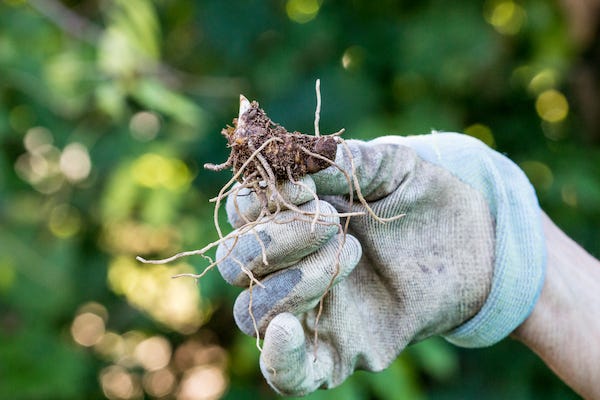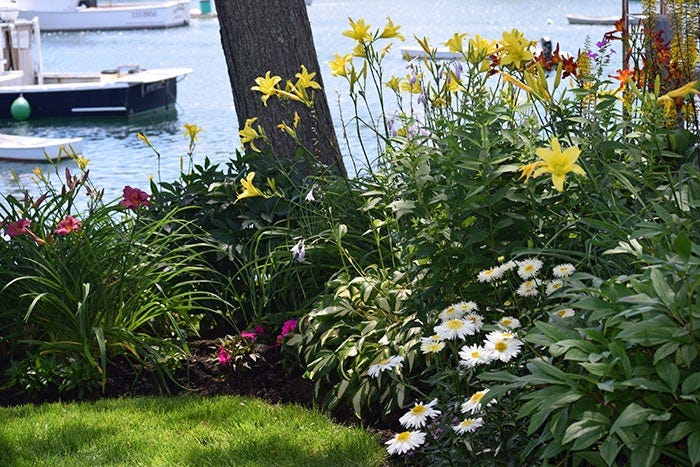Why Planting Bare Roots Is A Good Garden Investment
Bare roots have long been the most popular form of perennials for transplanting and mail-order nurseries. However, if you’re new to gardening, or accustomed to picking out potted plants from your local nursery rather than ordering plants by mail, you may be less familiar with bagged bare root plants. Don’t be discouraged – we’re here to tell you about bare roots, and why they are an excellent choice for any garden.
First, What Is A Bare Root?
“Bare Roots” are the root systems of dormant perennial plants. These plants are dug after they go dormant, the soil is removed from the roots, and they're packed in moist wood shavings, shredded paper, or peat moss.
What is a dormant plant? Most perennial plants go into a state of dormancy, or winter rest, as a result of the cold temperatures and shorter daylight hours of winter, re-grow from their roots with the arrival of spring’s optimal growing conditions.
The most important part of the plant is its root system. Healthy roots are the foundation of a healthy, vibrant plant. Bare roots hold all of the energy and genetic information the plant needs to grow. While in their dormant state, bare roots are easy to store and easy to ship.
Curious about what bare roots look like? Check out our Visual Guide To Bare Root Plants.
Comparing Potted & Bare Root Plants
- The best way to mail a plant depends on several factors, including its lifecycle and its form.
- Some plants perform best when transplanted as bare roots, and are not recommended to be transplanted as potted plants – which is true for most of our beautiful yet ephemeral Woodland Wildflowers.
- And on the other hand, some perennials are available in potted or bare root form, depending on the season or the grower – as you may see with popular Peonies or Milkweed. Some perennials cannot be stored or transplanted as bare roots, and are best shipped as potted plants.
What Are The Benefits Of Bare Root Perennials?
Purchasing Power
- Thanks to the ease of handling, your dollar often goes farther when purchasing bare roots than with potted plants
- Often, bare roots are more developed root systems than their potted counterparts
Shipping
- It’s easier to ship plants as bareroots because there is no chance to harm fragile growth in transit.
- Less shipping weight than potted plants means lower carbon footprint on shipping to your home
Transplanting & Growing
- They’re lightweight and easy to maneuver in the garden – no heavy potted plants to move around! This is especially helpful for larger plantings.
- Unlike potted plants, there is no need to acclimate to new soil, and no transplant shock plants when your plant bare roots.
- Since the plant is dormant, you don’t have to wait until after all chance of frost has passed. Dormant plants like to be planted as soon as possible, so they can wake up in their permanent place in the garden and start to spread their roots. All the energy and life force of the plant is being stored in the root, waiting to be planted to activate and generate fresh growth in your garden.
- The green foliage and blooms you find on plants at box stores and garden centers can be deceiving. Many of these plants are grown to look their best on the shelf, but as a result, they may be root-bound and therefore, won’t grow much larger than they are when you first plant them.
- Starting with a young, dormant bare root means that the new plants will acclimate to your garden quicker, and they are more likely to outgrow and outperform a root-bound perennial in the long run.
Which Plants Are Bare Roots?
We ship many of our most-loved perennials as bare roots for spring planting - including beloved Peonies, Daylilies, and Woodland Wildflowers. They're lightweight and easy to handle, and with no transplant shock, these healthy roots can take off and grow vigorously in the garden!
Peonies | Nothing beats the voluptuous beauty of a peony flower! Their incredible blooms are the welcome sign that gardening season is about to pop. These perennials do take a few years to establish, but they are incredibly long-lived when planted in the right conditions, living for decades and providing more amazing flowers each year.
Woodland Wildflowers | These bareroots are very small - as nature intended! Many of our woodland wildflowers are native, wild-collected plants, and they can take several years to establish, so there is some patience required. Their unusual beauty is well worth the wait! We're able to offer native wild species not cultivated for the trade, and these bareroots are smaller than those of cultivars or hybrids.
Lilies | We offer a broad selection of lilies, including Oriental Lilies, Tiger Lilies, Trumpet Lilies, and Asiatic Lilies. These delightful, quick-growing flowers are a great choice for layering the garden with bold blooms.
Daylilies | Thanks to their generous foliage display and cheerful, colorful flowers, these vigorous and low-maintenance perennials are a mainstay of any garden or landscape design.
Hostas | A must-have for any shade garden, Hostas grow quickly to create a lush and elegant groundcover with their broad, smooth foliage. They’re basically maintenance-free, and an easy way to fill in shaded edges and corners of the yard.
Astilbes | Astilbes are excellent at creating soft, colorful displays underneath trees, in low light corners, or in shady borders. These low-maintenance perennial plants make lovely foliage, and in late spring, send up plume-like flowers in a host of rich, glowing colors.
How To Plant Bare Root Perennials
For helpful planting information, visit The Tool Shed! You'll find our guides for general planting information about perennials, as well as detailed guides for growing the perennials listed above and many more. Learn more with The Tool Shed.
Shop Favorite Bare Root Perennials
What will you plant next? Shop some of our most popular bare root perennials, loved by our community of gardeners across the country.





